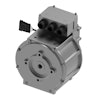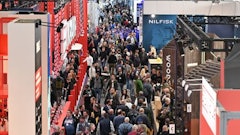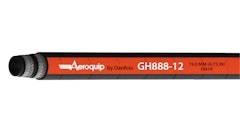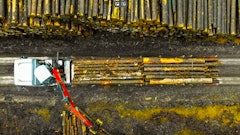The need for reduced fuel consumption and the requirements mandated by vehicle spectator noise emission regulations have caused engine idle speeds to be lowered. Further, as strict diesel emission standards take effect and new engine models are designed with higher power-to-weight ratios, these diesels produce a harsher driving torque with a large vibratory component.
Such developments in diesel engines and drivetrains have changed the requirements for torsional vibration suppression and motion control, which has prompted the need for increased driveline coupling/damper design features. These, and other factors, have created a host of new challenges in drivetrain design, demanding new solutions from improved couplings.
New solutions to an old problem
Industrial vehicle drivetrains are subjected to a variety of dynamic torque loading conditions. These include engine combustion and inertia, transient impulse, implement feedback, hydraulic clutch pressure irregularities, clutch friction coefficient variation and transmission shift energy management. These dynamic torque irregularities and shift shocks are superimposed upon the steady torque required to do work and can have damaging consequences on powertrain component life. In addition, they are often the root cause of noise, vibration and harshness (NVH), and thus have a significant impact on a vehicle's acceptance by end-users.
For these reasons, torsional vibration isolation, damping and drivetrain energy management should be a primary consideration during the design phase of a vehicle drivetrain.
The design initially begins with identifying the engine power curve data and then the drivetrain rotational inertia, which is needed to determine the fundamental drivetrain torsional natural frequency. The optimal torsional stiffness of the elastomeric torsional damper is computed from this data to place the natural frequency out of the engine operating range. It is crucial to specify a coupling early in the design phase in order to ensure there is enough space available for a coupling with the proper torque rating, torsional stiffness and additional driveline inertia.
Many well-established analytical techniques exist for determining torsional frequencies. Torsional systems can be analyzed using a simple two degrees of freedom model consisting of a spring, the driver and the driven mass moment of inertia, or a more complex model using the spring rate and mass moments of inertia within the engine, the driveline and the transmission. This information is input into software, which determines all the natural frequencies and mode shapes of the driveline system.
This process begins with an accurate definition of the torsional mass moment of inertia and stiffness series that describe the drivetrain's rotating elements (Figure 1). Once natural frequencies and associated mode shapes have been identified, probable excitation sources can be investigated to see if there will be a coincidence of natural and exciting frequencies or resonance within the drivetrain's operating speed range. Natural frequencies associated with most shafting, gears, splines and other rigid drivetrain components will normally be beyond the frequency range produced by engine firing.
The elastomeric torsional coupling is usually placed between the engine and drivetrain on the engine flywheel. The elastomeric coupling must be capable of transmitting full engine power, isolating combustion and inertia vibration, attenuating high torque shift shocks and providing a smooth power flow to the drivetrain.
Several types of elastomeric coupling designs can be considered, but the most popular for high torque and drivetrain energy management in off-highway vehicle applications is the annular shear type.
Case studies
Lord Corp., Cary, NC, developed a coupling comprised of an annulus of rubber that is vulcanize-bonded to a driven member and pre-compressed into an outer member. The rubber annulus provides a high torque loading capability with a low torsional stiffness that results in torsional isolation at higher operating frequencies. The Lord LCD Series coupling can accommodate shock torque loading up to at least three times the steady torque, and if higher torque spike amplitudes occur, the rubber annulus rotates within the outer member, which limits the torque applied to the driveline components.
It can accommodate shock torque loading, because it is capable of undergoing a large torsional rotation without a significant spring rate change throughout the rotation and it can undergo the large rotation with good fatigue resistance. Typical load deflection characteristics are shown in Figure 3.
Further, the LCD coupling has the effectiveness of hysteretic damping of the elastomer. Hysteretic damping provides good suppression of vibration at lower frequencies and good suppression of transient and random inputs but, unlike viscous damping, it does not have the disadvantage of increased transmissibility of vibration at higher frequencies. The coupling can thus reduce drivetrain component costs by limiting the torsional spikes and dissipating this energy within the polymer chains of the elastomer. Therefore, the dynamic torque load requirements for the mechanical drivetrain components can be reduced and provide an overall cost savings. Some examples of reduced cost components include driveshaft size, bearings, gears and reduced transmission clutch capacity.
The coupling/damper can also reduce clutch wear and improve shift performance. The LCD coupling isolates combustion and inertia torsional vibration within the diesel engine's operating speed range, allows limited misalignment between driving and driven shaft centers, absorbs and attenuates shift shocks, and provides smooth power flow. In most cases, it also reduces gear mesh noise, driveshaft megaphone resonances and structure-borne noise transmission.
Case in point is a recent application for one of the world's largest manufacturers agricultural equipment. According to Gene Pish, Lord Corp.'s Midwest regional sales manager, the company came to Lord because of the increase in warranty claims and failures in the field associated with its couplings. The coupling, used since 2002 on a higher horsepower tractor, had experienced a high number of premature coupling failures in the last two years. Upon inspection of the failed couplings, it was determined that some exhibited typical failure patterns associated with fatigue failure and torque overload.
Lord recommended that the company use the next size coupling in the LCD series in order to overcome the potential for torque overload. Performance testing showed that torsional vibration levels were within acceptable limits. According to Pish, even though the new, larger coupling is more expensive, the return on investment is substantial because of the decrease in warranty claims.
Another example is the switch to couplings on a new John Deere cotton harvesting machine. According to Jerry White, John Deere senior drivetrain engineer — cotton harvesters, the initial design concept on a recently introduced cotton picker used a rigid flex-plate bolted to the flywheel — a circular steel disk with a center, splined hub and no rubber element of any kind. Unfortunately, with this original concept, fretting on the hub-to-shaft splines occurred, and was unacceptable based on John Deere engineering requirements. There was also evidence of fretting at some ball bearing outer diameters within the gear box. Both these issues could result in reduced component life and possible machine down-time.
John Deere approached Lord about the problem in 2006 and a coupling was designed specifically for this application. With the vehicle scheduled for production starting in 2009, extensive field testing on the harvesters has validated that the spline and bearing fretting is no longer an issue when the Lord LCD coupling is used.
In addition, durability of the coupling has been proven by accumulating numerous lab test hours with no sign of degradation in performance. And as an added benefit, the magnitude of torsional vibrations within the engine was reduced.
Next steps
For today's coupling designer, an LCD Series elastomeric coupling can solve many problems in off-highway applications without the typical unwanted trade-offs because it offers the appropriate stiffness and large torsional deflection capabilities. For example, transients such as shift shock and resonance pass-through can be suppressed without sacrificing suppression of vibration at higher frequencies such as high idle engine speed. Key to success is addressing torsional vibration isolation, damping and drivetrain energy management early in the design phase of a vehicle drivetrain.
Shannon Sweeney, PE, is an engineering consultant for Lord Corp. and an assistant professor of engineering at Penn State Erie, The Behrend College. With a Master of Science in Mechanical Engineering, he has worked for 18 years in various capacities for a manufacturer and designer of vibration control products.
Tim Kubat is a senior engineering specialist at Lord Corp. He has worked on off-highway projects since 2000. With a B.S. in Mechanical Engineering, he has worked for Lord for more than 20 years as a product engineer.















